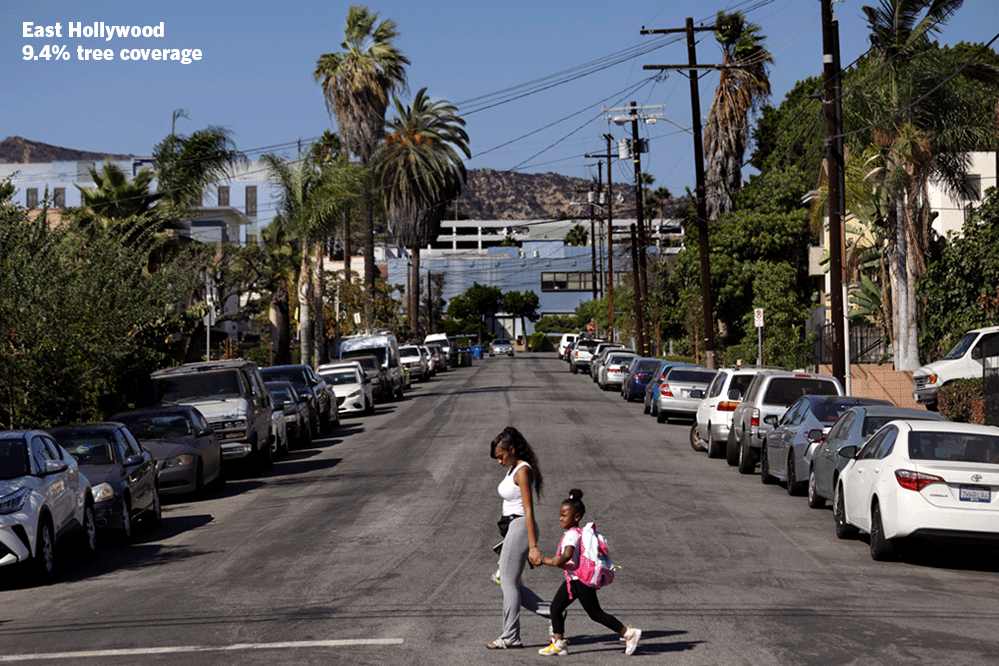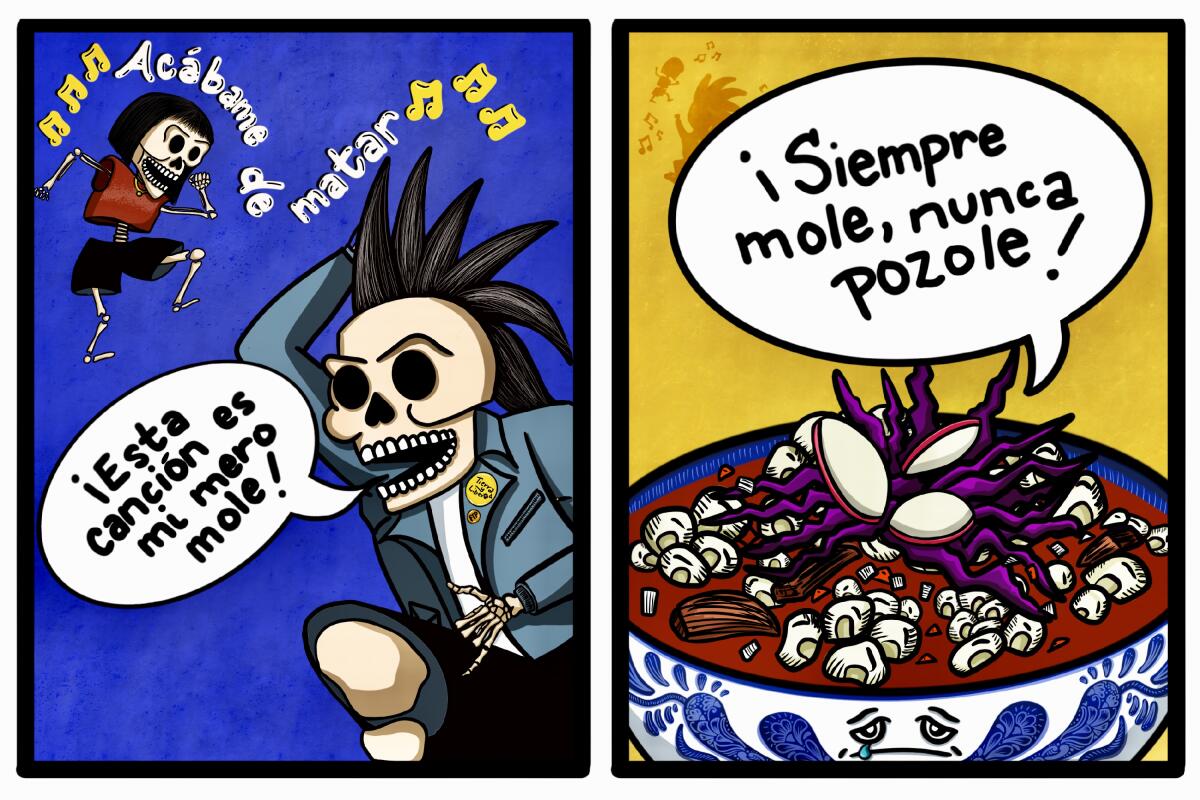Latinx Files: ‘Thermal inequity’ and who bears the brunt

- Share via
There is a graphic a few paragraphs into this story written by Tony Barboza and Ruben Vives about the “thermal inequities” that exist in Los Angeles that really makes clear what role the legacy of racism and discrimination has played in creating them.
It was made by assistant data and graphics editor Sean Greene, and it juxtaposes a map of L.A. neighborhoods that shows the surface temperature on July 14, 2018, with another that highlights the percentage of sun protection provided by the tree canopy in each area. They’re nearly identical. Neighborhoods with large Latinx, Black and Asian populations are a lot hotter than their white counterparts and also get less shade from trees.

According to a study conducted by UC Davis researchers, heavily Latinx neighborhoods in Los Angeles were 6.7 degrees hotter than neighborhoods with fewer Latinx residents during extreme heat days.
“These microclimates aren’t natural, they are man-made,” Rachel Morello-Frosch, an environmental health scientist at UC Berkeley, told The Times.
They’re also not exclusive to Los Angeles. Last year, researchers found that formerly redlined neighborhoods were nearly five degrees hotter than other areas.
“Heat waves don’t just kill people by coincidence,” said Vivek Shandas, a professor of urban studies and planning at Portland State University. “There’s really a set of conditions that are in place.”
The Latinx experience chronicled
Get the Latinx Files newsletter for stories that capture the multitudes within our communities.
You may occasionally receive promotional content from the Los Angeles Times.
A Times analysis found that extreme heat was a factor in over 3,900 deaths in California over the last decade, the hottest on record. This is six times higher than the official count of 599 heat-related fatalities reported by the state.
The scary part is things are only going to get worse.
According to a recent climate vulnerability assessment released by Los Angeles County, more than 1 million Angelenos live in areas that will experience an additional 30 extreme-heat days a year by 2050. These areas also happen to have large Latinx populations. Notice a trend?
With the pandemic, unemployment, income inequality and now “thermal inequities,” the Latinx community is bearing the brunt of another crisis. It almost makes you wonder if this could be a contributing factor to the seeming lack of urgency in addressing this issue.
For more, read the L.A. Times investigation into extreme heat’s deadly toll, which also includes a guide on how to protect your family.
Want to keep up to date with the latest climate change stories? Sign up for my colleague Sammy Roth’s Boiling Point newsletter.
Our daily news podcast
If you’re a fan of this newsletter, you’ll probably love our new daily podcast, “The Times,” hosted by columnist Gustavo Arellano, along with reporters from across our newsroom. Every weekday, it takes you beyond the headlines. Subscribe on Apple Podcasts and follow on Spotify.
Meet our Latinx staff: Vanessa Martínez
The Los Angeles Times employs more than 60 Latinx journalists. One of the goals of this newsletter is for you to meet them all. This week, we highlight Vanessa Martínez, a data and graphics journalist. Vanessa was the architect behind our Día de Muertos digital project. Without her, this project, which had the largest response for an L.A. Times audience call-out ever, would not have been possible. I asked Vanessa to tell you a little bit about her experience working on the digital altar.
We all go about our days, have our own experiences, and make our own memories. However, there are some that are universal. Among them are loss and grief.
Earlier this week, many celebrated Día de Muertos. While it’s a day to remember those who have passed away, it’s also a day to celebrate their lives. The memories you made together. The impact they had on your life.
To celebrate and give readers a public space to share recollections of their loved ones, the Los Angeles Times created a digital altar. We received more than 1,000 memories, stories and photos of grandparents, siblings, tíos, tías, friends and more (even pets). As we read through and published these beautiful tributes, I was reminded of my own family and friends.
When Fidel came to me with the idea of building a communal digital altar experience, I knew I wanted to be a part of it. Even though my family never really celebrated Día de Muertos or built altars at home, I was taught to always remember our loved ones. We’d visit the cemetery and take flowers to our relatives.
One of them is my dear cousin Alicia. She passed away 10 years ago to cancer. She was a sister, a daughter, a caring friend, a college student, a Dodgers fan, a softball player, and probably the biggest Hello Kitty fan I knew. I remember she once took my sister and me shopping in Old Town Pasadena. We were being silly and tried on pair after pair of sunglasses, laughing and taking selfies in front of a mirror — it was the MySpace era! — until an employee told us to stop taking photos. Boo! I couldn’t have worked on this project without making an ofrenda in remembrance of her. I am who I am today because of her impact on my life and the inspiration she is to me.
Working on the digital altar was a wonderful experience, and I’m thankful for the hundreds of people who entrusted us with their memories. Reading through the page, you can’t help but feel connected to others. You’re not alone in your loss. It doesn’t matter where you are in the world, celebrating the lives of those we love allows us to heal together.
Covering the issues, politics, culture and lifestyle of the Latino community in Los Angeles, California and beyond.
Things we dug this week that we think you will dig
— On the heels of Jenny69’s recent viral notoriety, columnist Carolina Miranda took a deep dive into the world of the buchona aesthetic. What’s buchona? Think of it as the paisa/narco-cultura’s answer to the girlboss. Miranda’s story also explores how the buchona style has expanded outside of the Mexican state of Sinaola thanks to social media.
— Congratulations to the Roosevelt High Rough Raiders for beating their longtime rivals the Garfield High Bulldogs in the 86th edition of the East L.A. Classic, the unofficial Mexican American Super Bowl (at least until the Dallas Cowboys and the Las Vegas Raiders face off in the actual Super Bowl) that pitted Boyle Heights (Roosevelt) against East L.A. (Garfield). This was the first win for Roosevelt over their rival in a decade, a win surely made sweeter after the game was postponed last year because of COVID-19. For more, read Luca Evans’ recap and watch el primo Steve Saldivar’s video.
— In his latest column, Mark Z. Barabak spoke with lawmaker Tony Cardenas about how bashing Donald Trump shouldn’t be the extent of the Democrats’ outreach to Latinxs in the upcoming midterm election. He also has some advice for them: “Understand what gets them to giggle. Understand what makes them laugh. Understand what gets them upset. Understand what makes them tick.”
By all means, Democrats. I dare you to figure out what it is that makes me giggle and laugh.
— What I’ve been listening to: The homies over at L.A. Taco, in collaboration with Neon Hum media, have a new podcast. “Smoke Screen: The Sellout” is a nine-part investigative series that chronicles the rise and fall of Jose Huizar, the onetime L.A. City Council member who was arrested and charged last year with racketeering, bribery and money laundering. What I like about the podcast is that it tells the story from the perspective of the residents of Boyle Heights, the community that raised Huizar.
Consider subscribing to the Los Angeles Times
Your support helps us deliver the news that matters most. Become a subscriber.
And now for something a little different ...

Yanely Rivas is a working-class Xicana, printmaker and visual artist with ancestral roots in the mountains and lakes of Michoacán, Mexico. As an anti-imperialist and internationalist at heart, she creates art as a way to address root causes of complex issues and as a mechanism to process, grieve, heal and envision.
“This comic celebrates the wittiness of Latine ‘dichos’ and my love for the latin-infused ska band, Panteón Rococó. Mole is a delicious dish that varies from region-to-region, family-to-family, and even person-to-person. Cada quien tiene su manera especial de cocinar su mole preferido. Hence, el uso del dicho ‘es tu/mi mero mole’ as an idiom that highlights an area of expertise or you know, ‘that’s my jam’ vibes. What dichos do you know?”
Are you a Latinx artist? We want your help telling our stories. Send us your pitches for illustrations, comics, GIFs and more! Email our art director at martina.ibanezbaldor@latimes.com.
The Latinx experience chronicled
Get the Latinx Files newsletter for stories that capture the multitudes within our communities.
You may occasionally receive promotional content from the Los Angeles Times.








